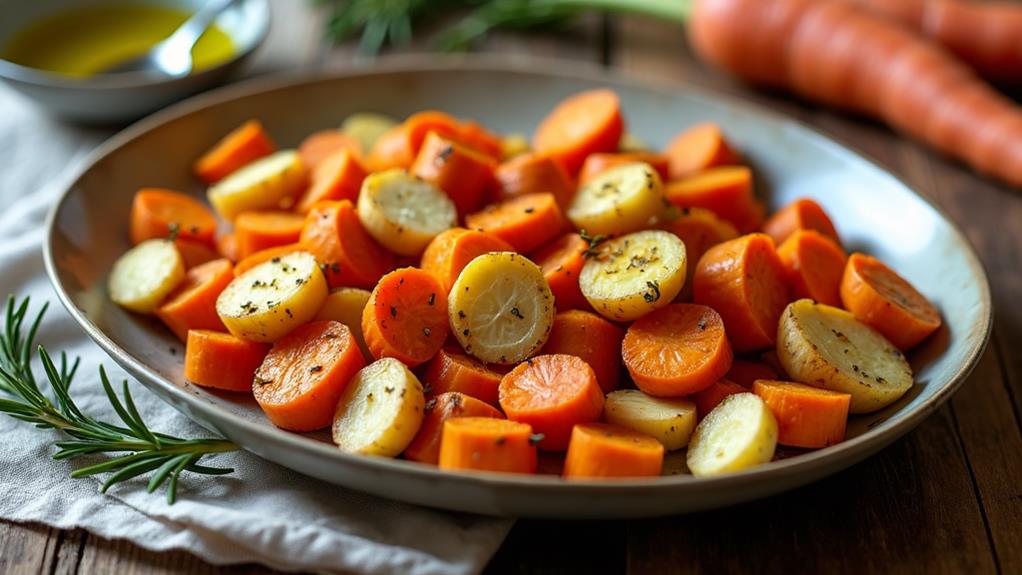You've likely encountered roasted root vegetables before, but you may not have fully appreciated their versatility and depth of flavor. This hearty medley combines the earthy sweetness of carrots, parsnips, sweet potatoes, and beets with the savory notes of herbs and olive oil. As you contemplate this simple yet satisfying dish, you'll find it's more than just a side—it's a celebration of seasonal produce that can stand on its own. But there's more to this rustic favorite than meets the eye. Its history and preparation techniques offer insights into culinary traditions and nutritional benefits that might surprise you.
Key Takeaways
- Root vegetables like carrots, parsnips, sweet potatoes, and beets are commonly used in roasted medleys.
- Toss cut vegetables with olive oil and herbs before roasting for enhanced flavor.
- Roast at 425°F (220°C) for 25-35 minutes, stirring halfway through for even caramelization.
- Arrange in a single layer on a baking sheet to prevent overcrowding and ensure crispy edges.
- Customize with different herbs, spices, or sweeteners to create varied flavor profiles.
History
Root vegetable dishes have been a staple in human diets for thousands of years. You'll find that our ancestors relied heavily on these nutrient-dense foods for sustenance, especially during harsh winters when other crops weren't available. The practice of roasting root vegetables dates back to ancient civilizations, where people discovered that cooking these hardy plants over fire enhanced their flavors and made them easier to digest.
As agriculture developed, root vegetables became increasingly important in various cultures worldwide. You'll notice that many traditional cuisines feature roasted root vegetables as side dishes or main courses. In medieval Europe, for example, turnips, carrots, and parsnips were commonly roasted in communal ovens.
The Industrial Revolution brought about new cooking methods, but roasting remained a popular technique for preparing root vegetables. Today, you'll find that roasted root vegetable medleys have experienced a resurgence in popularity.
This renewed interest is partly due to the farm-to-table movement and a growing appreciation for seasonal, locally sourced ingredients. You can now enjoy these timeless dishes in restaurants and homes alike, with modern twists on classic recipes.
Recipe
Roasted root vegetables are a delicious and comforting side dish that brings out the natural sweetness and earthy flavors of various root vegetables. This simple medley combines the hearty textures and rich tastes of carrots, parsnips, and sweet potatoes, creating a colorful and nutritious addition to any meal.
By roasting these vegetables together, you'll achieve a perfect balance of caramelized edges and tender interiors. The high heat of the oven intensifies their flavors, while a light coating of olive oil and a sprinkle of herbs enhances their natural taste. This easy-to-prepare dish isn't only versatile but also a great way to incorporate more vegetables into your diet.
- 2 medium carrots (about 1 cup or 150g), peeled and cut into 1-inch pieces
- 2 medium parsnips (about 1 cup or 150g), peeled and cut into 1-inch pieces
- 1 large sweet potato (about 2 cups or 300g), peeled and cut into 1-inch cubes
- 2 tablespoons (30ml) olive oil
- 1 tablespoon (3g) dried rosemary
Preheat your oven to 425°F (220°C). In a large bowl, toss the prepared carrots, parsnips, and sweet potato with olive oil and dried rosemary until evenly coated. Spread the vegetables in a single layer on a large baking sheet, ensuring they're not overcrowded.
Roast in the preheated oven for 35-40 minutes, stirring halfway through, until the vegetables are tender and golden brown around the edges. For best results, cut the vegetables into similarly sized pieces to ensure even cooking.
If you prefer a softer texture, cover the baking sheet with foil for the first 20 minutes of roasting, then remove it to allow the vegetables to brown. Feel free to experiment with different herb combinations or add a dash of balsamic vinegar before serving for extra flavor.
Leftovers can be stored in an airtight container in the refrigerator for up to 3 days and reheated in the oven or microwave.
Cooking Steps
To begin cooking your roasted root vegetable medley, you'll start by preparing the vegetables, tossing them with oil and herbs, and spreading them on a baking sheet.
Once your oven is preheated, you'll roast the vegetables until they're tender and golden brown, stirring halfway through for even cooking.
Step 1. Prepare Vegetables for Roasting

Preparation is key to achieving perfectly roasted root vegetables. Start by washing your carrots, parsnips, and sweet potato thoroughly under cool running water. Use a vegetable brush to remove any dirt or debris from the skin.
Next, peel the vegetables using a sharp peeler, making sure to remove any blemishes or tough spots. Once peeled, cut off the ends of the carrots and parsnips, and trim any remaining roots or stems.
Now, it's time to cut your vegetables into uniform pieces. Aim for 1-inch cubes or chunks, as this size allows for even cooking and optimal caramelization. For carrots and parsnips, slice them diagonally into 1-inch pieces. Cut the sweet potato into 1-inch cubes.
Remember, consistency in size is crucial for ensuring all vegetables cook at the same rate. As you cut, place the prepared vegetables in a large bowl.
Once you've finished cutting, you'll toss them with olive oil and herbs before roasting. This preparation step sets the foundation for a delicious and visually appealing roasted root vegetable medley.
Step 2. Toss With Oil and Herbs
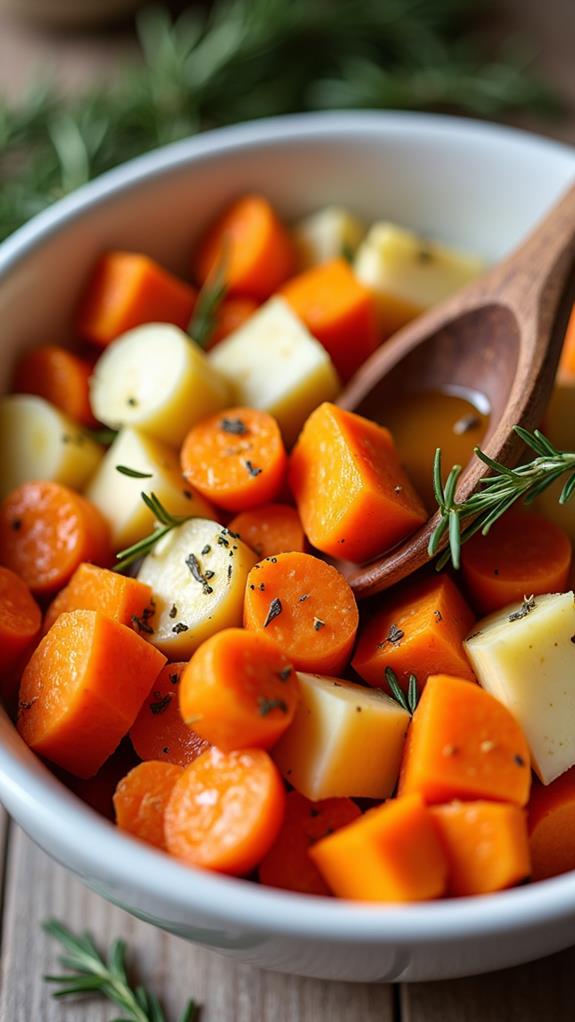
Once your vegetables are prepped, it's time to add flavor. Begin by drizzling two tablespoons of olive oil over your chopped carrots, parsnips, and sweet potatoes in a large mixing bowl. The oil will help the vegetables roast evenly and develop a crispy exterior.
Next, sprinkle one tablespoon of dried rosemary over the vegetables. This aromatic herb will infuse your dish with a fragrant, earthy taste that complements the natural sweetness of the root vegetables.
Using clean hands or a large spoon, gently toss the vegetables until they're evenly coated with oil and herbs. Be thorough but gentle to avoid breaking or mashing the softer pieces.
As you mix, you'll notice the oil and herbs distributing across the surfaces of the vegetables, creating a light, flavorful coating. This step is crucial for ensuring that every bite of your roasted medley is packed with taste.
If you prefer, you can experiment with other herbs like thyme or sage, or add a pinch of salt and pepper for extra seasoning. Remember, the goal is to enhance, not overpower, the natural flavors of your root vegetables.
Step 3. Spread Vegetables on Baking Sheet
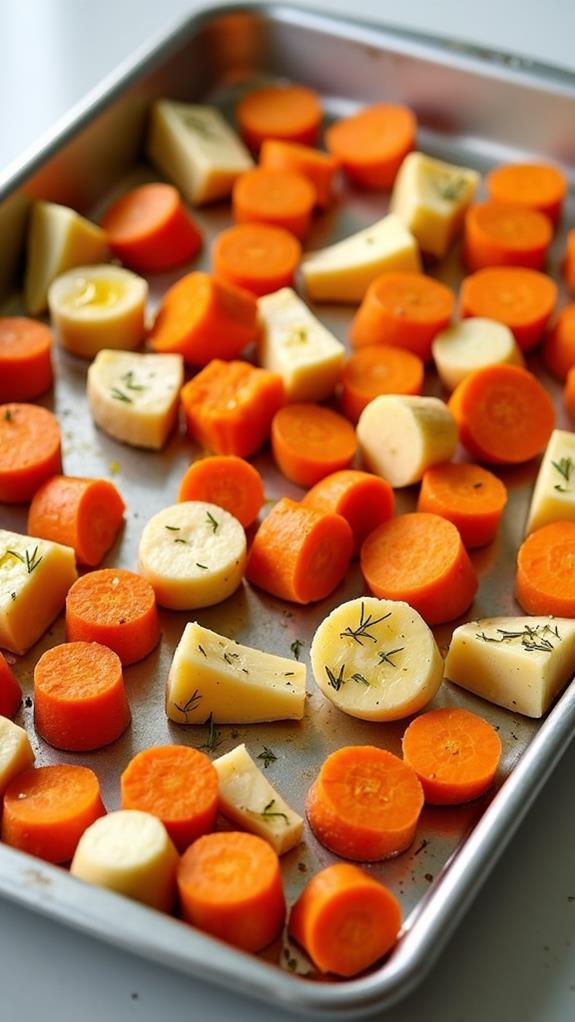
With your vegetables thoroughly coated in oil and herbs, it's time to prepare them for roasting.
Grab a large baking sheet and arrange the vegetables in a single layer. This step is crucial for achieving that perfect golden-brown exterior and tender interior.
Make sure you don't overcrowd the pan, as this can lead to steaming instead of roasting, resulting in soggy vegetables.
If you're working with a smaller baking sheet, it's better to roast in batches rather than piling the vegetables on top of each other. Leave some space between each piece to allow hot air to circulate freely. This ensures even cooking and promotes that desirable caramelization on all sides.
If you're using multiple types of vegetables with varying cooking times, consider grouping similar ones together on the sheet. For example, you might place carrots and parsnips closer together, as they often require similar roasting times.
Step 4. Roast in Preheated Oven
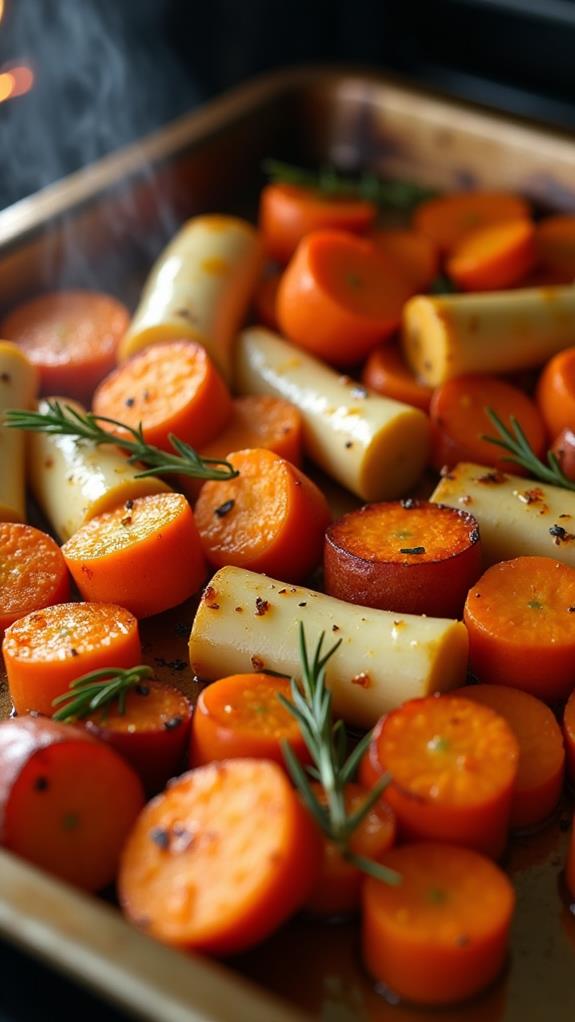
Roasting your prepared root vegetables is where the magic happens. Place the baking sheet with your evenly spread vegetables into the preheated 425°F (220°C) oven. The high heat will caramelize the natural sugars in the vegetables, creating a delicious golden-brown exterior while maintaining a tender interior.
Set your timer for 35 minutes, but don't forget to check on your vegetables halfway through. At around the 17-minute mark, carefully remove the baking sheet and give the vegetables a quick stir. This ensures even cooking and browning on all sides. If you notice some pieces cooking faster than others, rearrange them on the sheet, moving the less-cooked pieces to the outer edges where it's hotter.
After the full 35 minutes, assess your vegetables' doneness. They should be fork-tender and have a beautiful golden color. If they're not quite there, return them to the oven for an additional 5 minutes.
Once perfectly roasted, remove the sheet from the oven and let the vegetables cool slightly before serving. The result will be a fragrant, colorful medley of root vegetables with intensified flavors and irresistible textures.
Step 5. Serve and Enjoy Immediately
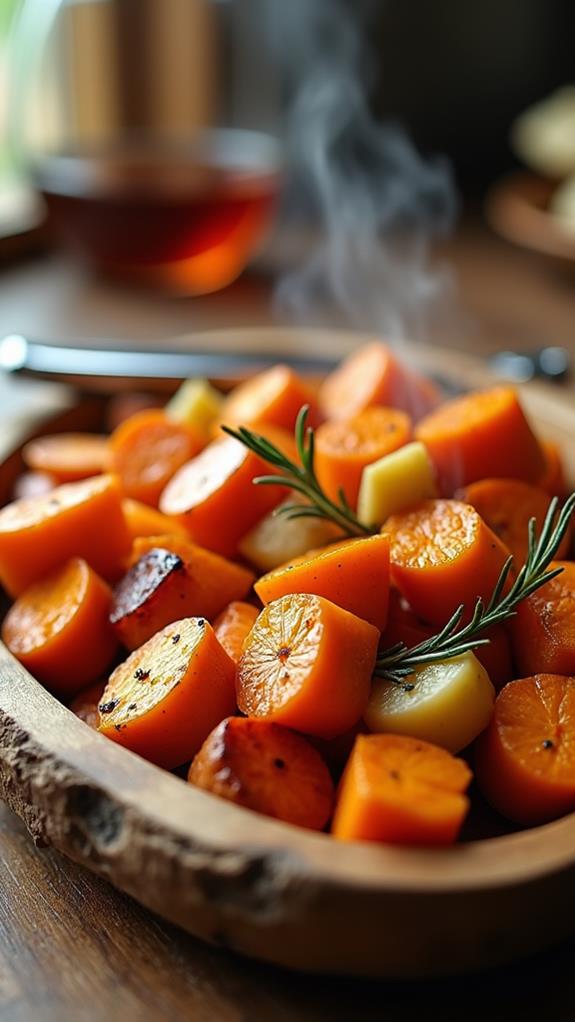
The aroma of perfectly roasted root vegetables fills your kitchen as you remove the baking sheet from the oven. You'll notice the vibrant colors and caramelized edges, indicating they're ready to be served.
Carefully transfer the hot vegetables to a serving platter or individual plates using a spatula. If you'd like, sprinkle a pinch of sea salt over the vegetables to enhance their flavors.
For a restaurant-quality presentation, arrange the different types of vegetables in distinct sections on the platter. This allows diners to appreciate the unique characteristics of each root vegetable.
You can garnish the dish with fresh herbs like thyme or parsley for an extra pop of color and flavor.
Serve the roasted root vegetable medley immediately while it's still hot and at its peak flavor. It pairs well with roasted meats, grilled fish, or as a standalone vegetarian main course.
If you're serving it as a side dish, consider offering a complementary sauce like a light yogurt dressing or balsamic reduction.
Final Thoughts
This versatile dish offers endless possibilities for customization and enjoyment. You can easily adapt it to your taste preferences or dietary needs by swapping out vegetables or experimenting with different herbs and spices.
Don't be afraid to try adding root vegetables like beets, turnips, or rutabagas to expand the flavor profile and nutritional benefits.
Remember that roasting is a forgiving cooking method, so you can adjust cooking times based on your desired level of caramelization. If you're short on time, cutting the vegetables into smaller pieces will reduce the cooking duration.
For a more indulgent twist, try drizzling the roasted vegetables with a touch of honey or maple syrup before serving.
Roasted root vegetables aren't just a side dish; they can be a versatile ingredient in other recipes. Use leftovers in salads, grain bowls, or puree them into a hearty soup.

